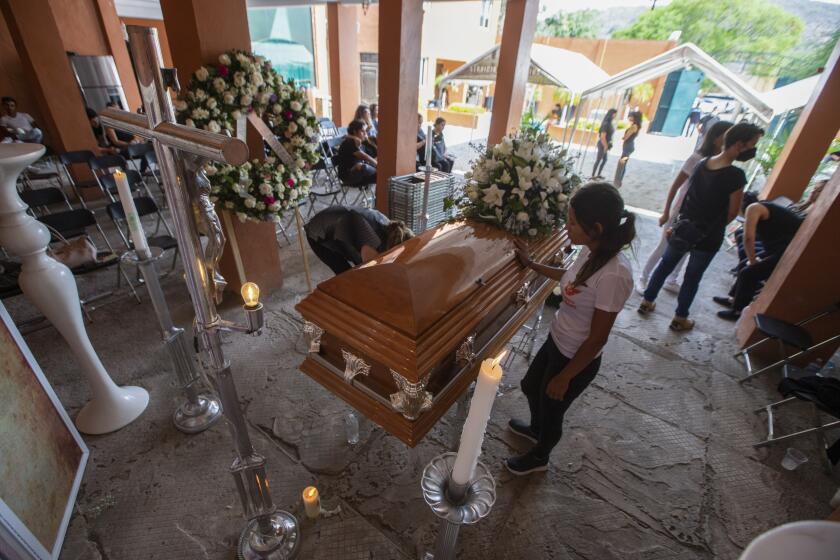Can words kill? Michelle Carter on trial for urging her 18-year-old boyfriend to kill himself
- Share via
Reporting from New York — Do words kill?
That is the gist of the decision facing Massachusetts Judge Lawrence Moniz in a landmark manslaughter case against a young woman who urged her 18-year-old boyfriend to commit suicide.
Michelle Carter was a troubled 17-year-old high school student when she sent her depressed boyfriend, Conrad Roy III, a barrage of messages belittling him for not having the courage to kill himself. “You always say you’re going to do it, but you never do,” she wrote.
Finally he did.
In July 2014, following her advice to “just park your car and sit there and it will take, like, 20 minutes,” Roy pumped carbon monoxide into the cab of his pickup truck in the parking lot of a Kmart. At one point, when he got out of the truck scared and already dizzy from inhaling the fumes, Carter ordered him to go back in.
The judge began his deliberations on Wednesday and has said he would announce a decision Friday at 11 a.m., eastern time. Carter faces up to 20 years in prison if convicted of involuntary manslaughter.
It was an unusual trial, short and to the point, since Carter had waived her right to a jury. The proceedings in the Bristol Juvenile Court, which lasted only one week, were live-streamed throughout.
There is little dispute about the evidence in the case. The communications were preserved in the form of thousands of pages of screenshots of text messages that laid bare, typos and all, the raw emotions of the young couple. Both had a history of psychiatric illness. Roy had attempted suicide four times previously, and Carter had a history of anorexia and cutting herself.
They met during a vacation in Florida in 2012, and although they lived about an hour apart, their relationship took place mainly by text messages. They discussed the possibility of dying together in a “Romeo and Juliet” pact.
Carter sent Roy her research on various methods of committing suicide, including one in which he would rig a generator to the car to kill himself with carbon monoxide. When he had trouble finding the right generator, she offered other suggestions: “Hang yourself, jump off a building, stab yourself idk there’s a lot of ways.”
Carter, now 20, a waif-like blond with furrowed eyebrows who appeared on the verge of tears throughout the trial, did not take the stand.
Instead, the defense relied heavily on the testimony of a controversial psychiatrist, Peter Breggin, a critic of the pharmaceutical industry and author of “Talking Back to Prozac.” He testified that Carter was “involuntarily intoxicated” and “enmeshed in delusion” by an antidepressant medication, Celexa, that she started taking a few months before Roy’s death, and had convinced herself that Roy would be better off dead.
“You’re finally going to be happy in heaven,” she texted him. “No more pain. No more bad thoughts and worries. You’ll be free.”
Two years earlier, the defense argued, Carter had been urging Roy to get psychiatric help and begging him not to kill himself.
“You have so much to live for please don’t,” she wrote to him on Facebook in 2012.
Defense attorney Joseph Cataldo argued, “Conrad Roy was on this path to take his own life for years,” he said. “It was Conrad Roy’s idea to take his own life. It was not Michelle Carter’s idea. This was a suicide, a sad and tragic suicide, but not a homicide.”
Prosecutors portrayed Carter as a manipulative and attention-hungry girlfriend who thought Roy’s suicide would cast her in the role of the grieving girlfriend and enhance her social status at high school.
“The defendant needed something to get their attention,” Assistant Dist. Atty. Maryclare Flynn said during the trial’s opening statements. “She used Conrad as a pawn in her sick game of life and death.’’
Although testimony about the secret life of teenagers made for compelling and at times salacious listening, the underlying legal issues have implications for future cases about free speech and assisted suicide.
Unlike 40 other states, Massachusetts has no law against assisted suicide, and the prosecution appeared to go beyond the scope of the existing law, said Sharon Beckman, a law professor at Boston College.
“Before this case, the law says that a person is responsible for their own suicide,” Beckman said. “That is the default common law and applies no matter what the other person said or whether they handed them the weapon.”
The novelty of the case also lies in the fact that the defendant rarely saw the deceased and that most of their relationship had taken place in cyberspace.
“Back years ago, in order to have a relationship you had to actually see somebody — or at a minimum talk on the phone,” one of the prosecutors, Katie Rayburn, said during her closing argument.
“That is no longer required. People fall in love via the Internet and via text. People bully via text and the Internet. You can encourage someone to die via text, and you can commit a crime via text.”
In a Massachusetts Supreme Court decision last July upholding the state’s right to try Carter, the court ruled that she was “virtually present” when Roy died.
Elsewhere, prosecutors have stumbled trying to bring convictions over suicides. Dharun Ravi, a Rutgers student, was convicted of bias intimidation, invasion of privacy and other crimes in 2012 after the suicide of his roommate whom he had recorded in a romantic encounter with another man. The case was thrown out on appeal, and he pleaded guilty to lesser charges.
In the case of a Missouri mother, Lori Drew, who set up a fake MySpace account that bullied a girl who later committed suicide, prosecutors decided not to bring charges against her in connection with the death. A 2008 conviction for computer fraud was later thrown out.
To read the article in Spanish, click here
ALSO
Polygamous sect leader Lyle Jeffs captured after being on the run for a year
Virginia gunman hated Republicans, and ‘was always in his own little world’
Trump administration will press Central American countries and Mexico to keep their people at home
More to Read
Sign up for Essential California
The most important California stories and recommendations in your inbox every morning.
You may occasionally receive promotional content from the Los Angeles Times.










